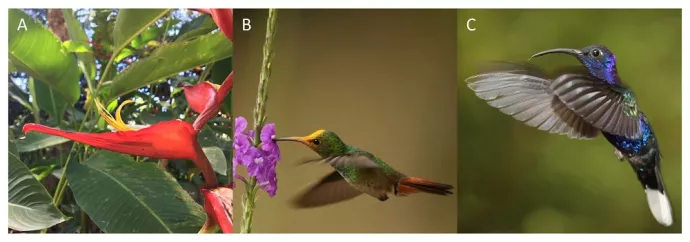
Felipe Torres-Vanegas' 1st first paper is all about Pollination
Felipe Torres-Vanegas, PhD student in Helene Wagner Lab, had his 1st first authored paper published in December 2019 edition of Frontiers in Genetics (Evolutionary and Population Genetics).
The Landscape Genetic Signature of Pollination by Trapliners: Evidence From the Tropical Herb, Heliconia tortuosa
"Animal-mediated pollination is essential for the maintenance of plant reproduction, especially in tropical ecosystems. However, accumulating evidence suggests that not all floral visitors provide equally effective pollination services, reducing the number of realized pollinators and increasing the specialization of pollination networks. Thus, there is a need to understand how different groups of pollinators influence pollination success.
We examined whether patterns of pollen flow in Heliconia tortuosa are consistent with the foraging strategy of its territorial or traplining hummingbird pollinators. Territorial hummingbirds defend clumps of flowers and are expected to transfer pollen locally. In contrast, traplining hummingbirds forage across longer distances, thereby increasing pollen flow among forest fragments, and are thought to repeatedly visit particular plants. If trapliners indeed visit the same plants repeatedly along their regular routes, this could lead to a situation where neighboring plants sample distinct pollen pools.
To test this hypothesis, we performed TwoGener analysis to test pollen pool differentiation within sites (among neighboring plants within the same forest fragment) and between sites (among forest fragments). We found strong, statistically significant pollen pool differentiation among neighboring mother plants, and weaker, statistically significant differentiation among sites.
We interpret this pattern of pollen pool differentiation as the landscape genetic signature of the foraging strategy of traplining hummingbirds, where repeatable, long-distance, and high-fidelity routes transfer pollen among particular plants. Although H. tortuosa is also visited by territorial hummingbirds, our results suggest that these pollinators do not contribute substantially to successful pollination, highlighting differences in realized pollination efficiency. This reduction in the number of realized pollinators increases the vulnerability of pollination success to the decline of populations of traplining hummingbirds, which have been shown to be sensitive to forest fragmentation.
We conclude that maintaining habitat connectivity to sustain the foraging routes of trapliners may be essential for the maintenance of pollen flow in human-modified landscapes." (Felipe Torres - Vanegas, PhD Student)

